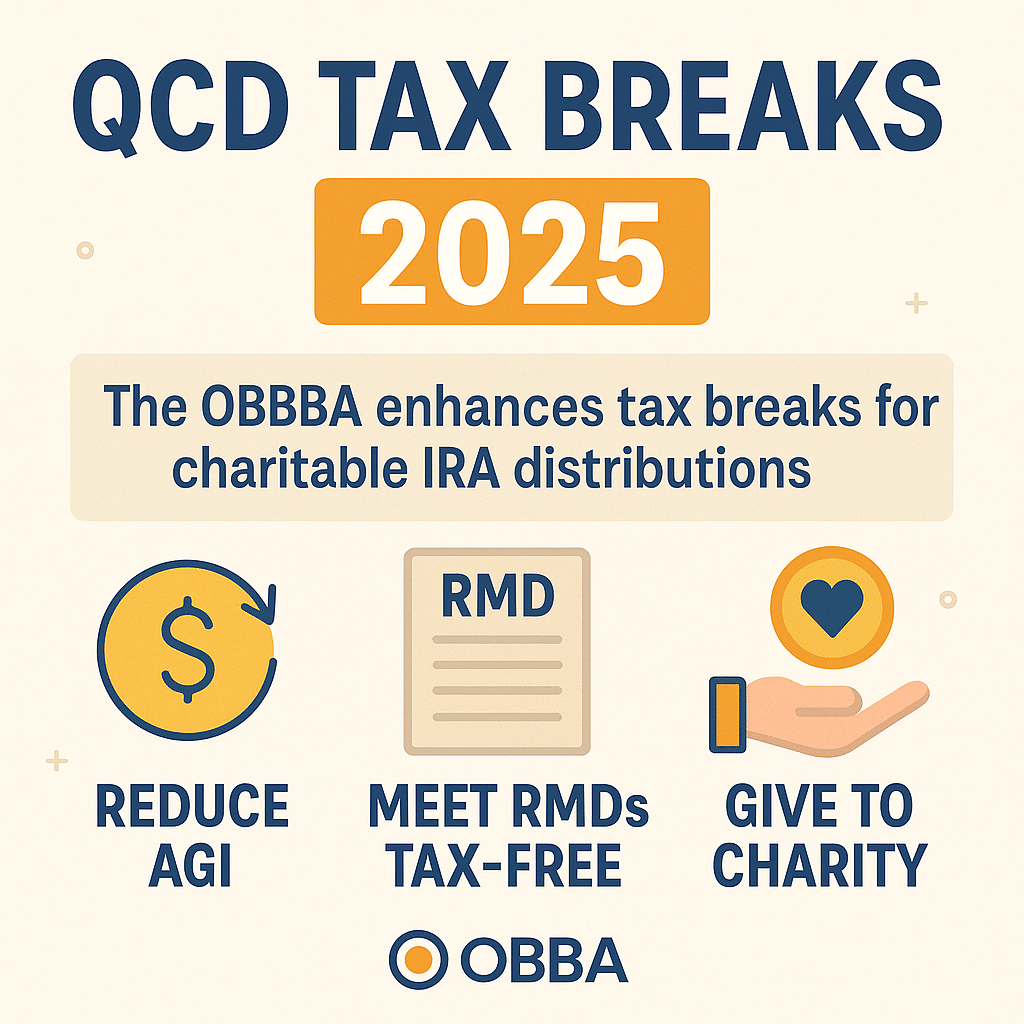If you’re age 70½ or older, there’s a little-known way to give to charity that can significantly reduce your taxes: making a qualified charitable distribution (QCD) directly from your IRA.
The One Big Beautiful Bill Act (OBBBA) has expanded the benefits of this strategy, creating more opportunities for retirees to lower their taxable income while supporting the causes they care about. Here’s what’s changed — and why QCDs may be one of the most effective giving tools for 2025 and beyond.
What Is a Qualified Charitable Distribution (QCD)?
A QCD lets you send funds directly from your traditional IRA to an IRS-approved charity without paying income tax on the amount transferred. It’s not treated as an itemized deduction — it’s simply excluded from income altogether.
You must be at least age 70½, and the transfer must go directly from your IRA custodian to the charity. You cannot receive any benefit (such as tickets, goods, or services) in return, and QCDs can’t come from a SEP or SIMPLE IRA.
For 2025, you may give up to $108,000 per person — and if you’re married, each spouse with their own IRA can give up to that amount.
Why QCDs Are More Powerful After the OBBBA
Because the OBBBA introduced new income-based limits and phaseouts, keeping your adjusted gross income (AGI) low is more valuable than ever. QCDs don’t increase AGI, which allows taxpayers to avoid or minimize several hidden tax costs.
With QCDs, you can:
• Avoid being bumped into a higher tax bracket.
• Bypass the 60% of AGI cap on charitable deductions.
• Sidestep the new 0.5% AGI floor on charitable write-offs (starting 2026).
• Avoid itemized deduction reductions for high earners.
• Preserve the new Senior Bonus Deduction (up to $6,000 per spouse).
• Keep the expanded SALT deduction ($40,000 in 2025) fully available.
• Prevent the 3.8% Net Investment Income Tax from being triggered.
• Lower your Medicare IRMAA premiums by keeping MAGI down.
In essence, QCDs help you maintain access to deductions and credits that might otherwise disappear due to income thresholds — all while making a charitable impact.
QCDs Can Satisfy Your Required Minimum Distributions (RMDs)
Once you reach age 73, the IRS requires you to take annual minimum distributions (RMDs) from your retirement accounts. Those RMDs are normally taxable, but QCDs can count toward that requirement without being taxed.
For example, if your RMD is $20,000 and you give $20,000 directly from your IRA to a charity, you’ve met your RMD obligation with zero tax owed.
Timing matters: the QCD must occur before taking your RMD for it to count. Once you’ve withdrawn an RMD into your own account, it can’t be retroactively converted into a QCD.
Tax Coordination for Non-Deductible IRA Contributions
If your IRA includes both deductible and non-deductible contributions, QCDs are treated as coming from the taxable portion first. The benefit: your QCDs remain tax-free, and the non-deductible (basis) portion stays in your account for future tax-free withdrawals.
This structure allows you to maintain long-term flexibility while still meeting charitable and tax planning goals.
Estate and Legacy Benefits
Even though the federal estate tax exemption is currently very high ($13.99 million for individuals and roughly $28 million for married couples in 2025), QCDs can help reduce future estate exposure by removing assets from your taxable estate.
For families with philanthropic goals, this is a simple, direct, and IRS-compliant way to build charitable giving into a legacy strategy.
Important Limitations for Post-70½ IRA Contributions
Since 2020, individuals over age 70½ can make IRA contributions if they have earned income. However, any deductible contributions made after turning 70½ reduce the portion of future QCDs that can be excluded from income.
In other words, if you’ve made post-70½ deductible IRA contributions, your first few QCDs might not be fully tax-free until those contributions are “offset.”
How to Report QCDs on Your Tax Return
On your Form 1040, report the full amount of IRA distributions (including QCDs) on Line 4a, and only the taxable portion (if any) on Line 4b — write “QCD” next to the line.
If you have any non-deductible IRA basis, file Form 8606 to report the remaining basis and confirm the nontaxable portion.
Who Should Consider QCDs
You may benefit from using QCDs if:
• You claim the standard deduction and don’t itemize charitable gifts.
• You’re required to take RMDs but don’t need the extra income.
• You want to reduce AGI to preserve other tax deductions and credits.
• You want to simplify charitable giving and estate planning.
With an annual limit of $108,000 per person ($216,000 for couples), QCDs provide one of the most flexible and tax-efficient ways to give during retirement.
Key Takeaway
QCDs are one of the rare tax planning strategies that combine generosity and efficiency. They allow retirees to give directly from IRAs, satisfy RMDs, reduce taxable income, and keep more deductions and credits intact — all under the expanded benefits of the OBBBA.
👉 IRS – Qualified Charitable Distributions (QCDs)
👉 Medicare IRMAA Premium Information
👉 Reckenen Tax Planning Services
👉 Schedule a Consultation
Legal Disclaimer
This information is for general educational purposes only and should not be construed as legal, accounting, or tax advice. You should consult your tax advisor regarding your specific circumstances before making financial or charitable decisions. Tax laws are subject to change, and interpretations vary based on individual situations.

